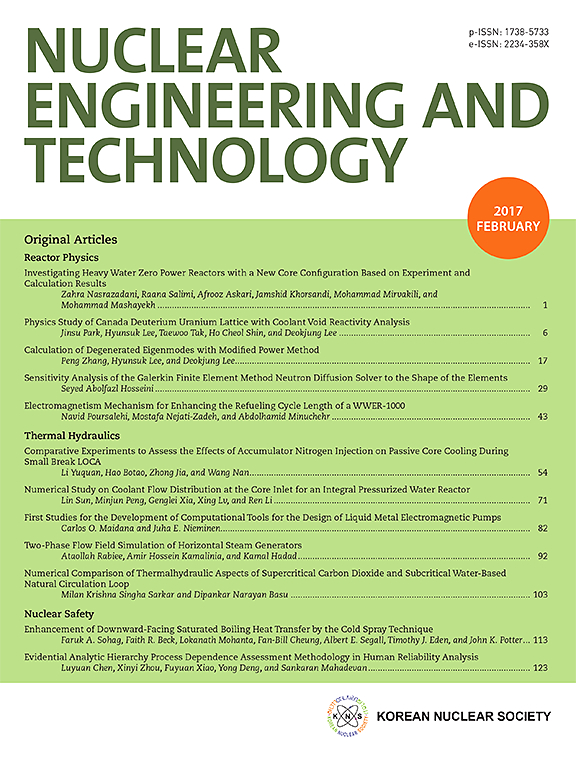Probabilistic Model Chain Methodology for evaluating radiological consequences of accidents in High-Temperature Gas-Cooled Reactor
IF 2.6
3区 工程技术
Q1 NUCLEAR SCIENCE & TECHNOLOGY
引用次数: 0
Abstract
Dose consequence analysis models are pivotal in Nuclear Safety Analysis, particularly for assessing radiological consequences following nuclear accidents. As many new reactor designs, including High-Temperature Gas-Cooled Reactors (HTGRs), are expected to be located closer to populated areas and propose significantly smaller Emergency Planning Zones (EPZs), accurate consequence analysis becomes increasingly vital. This paper presents a novel Probabilistic Model Chain Methodology (PMCM), beginning with core state estimation using SERPENT2, followed by source term characterization through the Idaho National Laboratory Model, and culminating in the generation of weather scenarios based on empirical models. These data are produced probabilistically, leading to simulations of radionuclide transport and dose assessment using the JRODOS system. The methodology is illustrated using the HTGR TeResa design and a Depressurized Loss of Forced Cooling accident scenario for the reactor’s location at the National Centre for Nuclear Research in Poland. The resulting dose spatial results are compared with dose limits, as well as dose values across distances from the site, highlighting the highest dose maps. This is achieved through integrated uncertainty across several models, enhancing potential modularity and applicability of the methodology to other reactor types and accident scenarios.
评价高温气冷堆事故辐射后果的概率模型链方法
剂量后果分析模型是核安全分析的关键,特别是对核事故后辐射后果的评估。由于许多新的反应堆设计,包括高温气冷堆(htgr),预计将位于离人口稠密地区更近的地方,并提出更小的应急规划区(EPZs),准确的后果分析变得越来越重要。本文提出了一种新的概率模型链方法(PMCM),首先使用SERPENT2进行核心状态估计,然后通过爱达荷州国家实验室模型进行源项表征,最后基于经验模型生成天气情景。这些数据是概率产生的,导致使用JRODOS系统模拟放射性核素运输和剂量评估。该方法使用HTGR TeResa 40MWth设计和波兰国家核研究中心反应堆位置的减压强迫冷却损失事故场景来说明。将所得的剂量空间结果与剂量限值以及距场址各距离的剂量值进行比较,突出显示最高剂量图。这是通过集成多个模型的不确定性来实现的,增强了潜在的模块化和方法对其他反应堆类型和事故场景的适用性。
本文章由计算机程序翻译,如有差异,请以英文原文为准。
求助全文
约1分钟内获得全文
求助全文
来源期刊

Nuclear Engineering and Technology
工程技术-核科学技术
CiteScore
4.80
自引率
7.40%
发文量
431
审稿时长
3.5 months
期刊介绍:
Nuclear Engineering and Technology (NET), an international journal of the Korean Nuclear Society (KNS), publishes peer-reviewed papers on original research, ideas and developments in all areas of the field of nuclear science and technology. NET bimonthly publishes original articles, reviews, and technical notes. The journal is listed in the Science Citation Index Expanded (SCIE) of Thomson Reuters.
NET covers all fields for peaceful utilization of nuclear energy and radiation as follows:
1) Reactor Physics
2) Thermal Hydraulics
3) Nuclear Safety
4) Nuclear I&C
5) Nuclear Physics, Fusion, and Laser Technology
6) Nuclear Fuel Cycle and Radioactive Waste Management
7) Nuclear Fuel and Reactor Materials
8) Radiation Application
9) Radiation Protection
10) Nuclear Structural Analysis and Plant Management & Maintenance
11) Nuclear Policy, Economics, and Human Resource Development
 求助内容:
求助内容: 应助结果提醒方式:
应助结果提醒方式:


